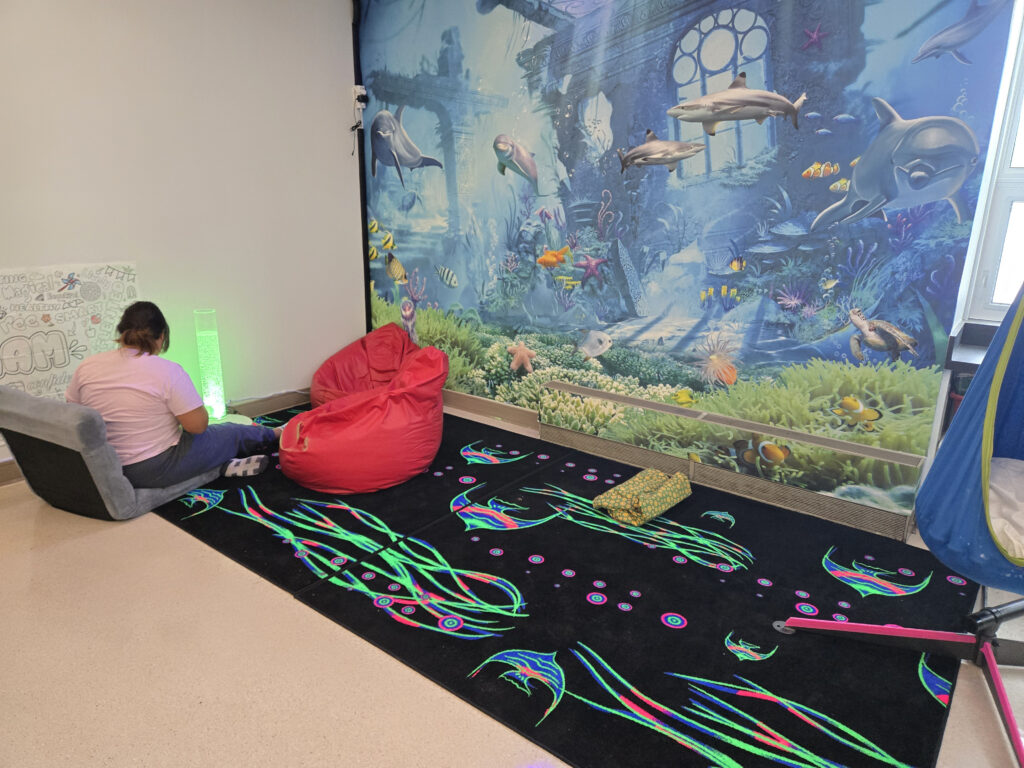Over the past year, Mary Tonello, Special Education Resource Teacher for Our Lady of the Way school, tapped into provincial funding to create a space where students can regulate their emotions, unwind or energize themselves. This “alternative learning space” includes a glow-in-the-dark rug, lights for students to fidget with, and other ways to meet students’ emotional and sensory needs.
Tonello thinks this is a growing trend in education, and affords students dignity. While this wasn’t around when Tonello was in school, she thinks “it would have been nice” to have a space like this when she was a student. She feels it gives students “breathing room” to feel their feelings.
“So, basically the Ministry [of Education] sets aside different amounts of money for school boards and gives different areas that they’re looking to improve in schools,” said Tonello. “It gives teachers the opportunity to apply and come up with a plan to utilize those funds on one of the initiatives.”
Last year, Tonello took it upon herself to apply for funding to help students with their mental health.
“Last year, one of them was self-regulation and mental health for students. So I put in an application for that to help create a space in our school where students would have access to a space that would help them learn about emotions, about their body, to help react to different emotions and to help regulate.”
According to Tonello, this is useful for students and teachers alike because many students have sensory needs.
“A lot of kids have sensory needs,” said Tonello, “I think all of us do, even as adults. I wanted to make it more of a sensory room that also could function as an alternative learning space or have different tools.” Adding, “What we created was a space where we can meet their emotional needs, their sensory needs, and their learning needs.”
Some of the ways students can meet those sensory needs include space where they can “get the body moving” in addition to a calming area complete with a glow-in-the-dark rug.
“We set it up where there’s a lot of space in the room, where they can do large movements, have compression, and do different things that kind of get the body moving,” said Tonello. “We also have a calming area that has a glow-in-the-dark carpet and it has a bubble tube that lights up and bubbles go up and down inside of it. We also have little lights that they can have in their hands and play with, and we have a light up table we can put either water, rice or sand, which also gives different sensory input for kids”
Tonello notes that “calming corners” like this appear to be a growing trend in Ontario education, and suggests students need additional space.

“A lot of classrooms, too, are having calming corners for kids. So I think if the school doesn’t have space in corners for classrooms, they need to have an additional space for students,” said Tonello. “Having that space where they’re not in front of their peers and being watched is really important to give them that space to feel those emotions, feel safe, and give them some dignity.” Adding, “I do think every school should have at least one.”
Moreover, Tonello thinks it would have been nice to have a space like that when she was in school.
“It would have been nice,” said Tonello. “I was a student in the ’90s. So, it was desks, it was rows, it was you sat down and you did your work. I think these flexible spaces give kids the ability to learn about how they learn best and what they need to be successful. Back when I was a kid, we all did things the same. You thrived or you didn’t. Now they can say, ‘I work better in a quiet space’ or, ‘I work better with my headphones in,’ or ‘I like dim lighting because the lights hurt my eyes.’ So, giving a space like that, I think it would have been nice having it back in my day.”
Furthermore, Tonello notes this space gives students a chance to advocate for themselves.
“It lets them be able to speak up to what they need and advocate for themselves and their learning,” said Tonello. “It just kind of lets everybody have that breathing room and see who they are and feel their feelings.”







